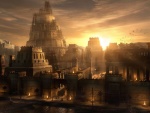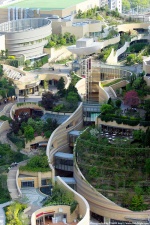Difference between revisions of "Khem"
m |
m (→Geography) |
||
| (135 intermediate revisions by 2 users not shown) | |||
| Line 1: | Line 1: | ||
__NOTOC__ | __NOTOC__ | ||
| − | {{Infobox | + | |
| − | + | {{Infobox country | |
| − | + | |color= maroon | |
| − | + | |text_color= yellow | |
| − | + | |name=al'Khem | |
| − | + | |title='''Peoples Confederation of Holy Isles''' | |
| − | + | |native_name=Քհէմ Դափգէֆ Ոփկաէա | |
| − | + | |translit_name=''Khem Ta'cef O'Gaea'' | |
| − | + | |flag=Al khem 216703.jpg | |
| − | + | |arms=Khem Coat of Arms.jpg | |
| − | + | |map=KhemMapAerialView.png | |
| − | + | |motto=''Beginning ending cosmic age we are one material bound to self.'' | |
| − | + | |native_motto='''Aթեirժեներ ժաNՕսմո գաiմի''' | |
| − | + | |translit_motto= Apeiros kn'osmo gaea | |
| − | + | |anthem=''Glorious Ta'' | |
| + | |native_anthem='''Սրանք բայց''' | ||
| + | |translit_anthem =Ta Lī Ma | ||
| + | |area=845,375.52 | ||
| + | |water_area=75% | ||
| + | |high_point=[[Mount Kallisti]] 3023M | ||
| + | |long_river=[[River Gentu]] | ||
| + | |population=102,521,000 | ||
| + | |density=482 by land (1,206 actual) | ||
| + | |growth=0.2 | ||
| + | |median_age=21.5 years | ||
| + | |demonym=Khem | ||
| + | |event1=Founding of [[Pan-Cefnor Trade Company]] | ||
| + | |event1_date=1605 CE | ||
| + | |event2=[[Children of Ta Revolt]] | ||
| + | |event2_date=1850 CE | ||
| + | |capital=[[Carcossa]] | ||
| + | |official_language=Khem | ||
| + | |type=Democratic Confederation of City States, Previously Theocratic Principalities | ||
| + | |legislature=[[The Hall of Amenti]] | ||
| + | |office1=[[En'ku]] | ||
| + | |official1=Mk'aelar Bara'war | ||
| + | |office2=[[Alkahest]] | ||
| + | |official2=Manas Vol'elen | ||
| + | |subdivision_name=Islands | ||
| + | |subdivisions=137 | ||
| + | |currency=[[Ta]] | ||
| + | |currency_symbol=≗ | ||
| + | |currency_code=T | ||
| + | |GDP=≗ 3.27 trillion | ||
| + | |per_capita_GDP=≗ 36,179 | ||
| + | |GDP_growth=9 | ||
| + | |gini=.34 | ||
| + | |agriculture=34 | ||
| + | |industry=45 | ||
| + | |services=21 | ||
| + | |unemployment=2 | ||
| + | |life_expectancy=102 | ||
| + | |water_access=100 | ||
| + | |literacy=98 | ||
| + | |gross_enrollment=73 | ||
| + | |primary=73 | ||
| + | |secondary=65 | ||
| + | |tertiary=20 | ||
| + | |measures=[[Eluvataran-Myrorian Standard]] (Metric) | ||
| + | |dates=month-day-year | ||
| + | |traffic=Right-hand | ||
| + | |iso_code=AK | ||
| + | |TLD=.kh | ||
| + | |telephone=42 | ||
}} | }} | ||
| + | |||
[[Category: RP Nations]] | [[Category: RP Nations]] | ||
| − | + | <blockquote> | |
| + | "When I call them Librarians, let me not be understood as meaning no more than the term denotes with you. With us, our Librarians were administrators of all business, art, and science; Directors of trade, commerce, generalship, architecture, engineering, education, statesmanship, legislature, morality, theology; doing nothing themselves, they were the cause of everything worth doing, that was done by others." | ||
| + | -excerpt of a study on Khemish culture by doctoral student Jain Wei while studying at the Imperial College at Fellowmoor-</blockquote> | ||
| + | <br> | ||
| + | '''Khem''', sometimes known as '''The Khem''' or '''Al'Khem''', is an archipelago nation home to one of Taijitu's oldest civilizations. The Khemish civilization dates back 19,000 BCE as the first evidence of Khemish agrarian villages show themselves emerging from the nomadic al'Ta, there was also a division of burial practices in this time with the al'Khem beginning to use mounds as opposed to the al'Ta tree burial. These agrarian villages eventually became the principalities of Khem, whose caste systems defined the Khemish people for thousands of years. The cities of the al'Khem eventually became engineering marvels of the ancient world, perfectly blending land and water through canals, chinampas, hugelkultur and dams. The wealthy Librarians, the caste at the top of Khem society, controlled nearly everything and lived extravagantly, though eventually losing their grip on reality and soon after ruler-ship. Da'Kavo, a slave soldier caste, patrolled the streets acting as violent enforcers of Library edict in addition to their position in fighting foreign enemies. The builder caste, designed and lived comfortable, simple lives for themselves. While the "Servile" caste ostensibly had it the worst and were the forefront of historic revolutions, riots and civil rights movements. Lastly are the al'Ta who are a scattered tribal people still dwelling in the Hyades rain-forest and along various waterways in al'Khem, they practice an ancient animistic version of the Libraries Path of Truth. It is a multicultural nation, consisting mainly of ethnic Khems, Ozians, Moacians, Jutensans, Iadakans, Fre'zhi, Kar'zhi, Bustians, Lycanthropes, Dunedain, Edain, Minosian, Benn, Finn, Belaedinosi, and Funkadelians. Despite widespread poverty among the working class, an abundance of food ensures no Khem goes hungry. | ||
| − | + | ==Government== | |
| − | + | {| class="wikitable" | |
| − | + | |- | |
| − | + | !Country Name: | |
| − | + | | | |
| − | + | Conventional Long Form: Peoples Confederation of al'Khem<br> | |
| − | + | Conventional Short Form: Khem<br> | |
| − | + | Abbreviation: P.R.K.<br> | |
| − | + | Government Type<br> | |
| − | + | Thalassocratic Republic <br> | |
| − | + | |- | |
| − | + | !National Holidays: | |
| − | + | | | |
| − | <br> | + | Freedom Day: February 14<br> |
| − | + | Victory Festival: June 16 - June 26<br> | |
| − | + | Solstices and Equinoxes<br> | |
| − | <br> | + | Full Moons<br> |
| − | <br> | + | |} |
| − | <br> | + | |
| − | <br> | + | ==Languages:== |
<br> | <br> | ||
| + | Official Languages: Khem, Eruvite, Ozian <br> | ||
| + | ---- | ||
| + | Recognized Languages: [[Cefish]], Jutensan, (other languages of the [[Cefnor Basin]])<br> | ||
| + | The Most commonly spoken secondary language is Ozian. <br> | ||
| + | Followed closely by Eruvite. Many fisherman and gardeners know Jutensan.<br> | ||
| + | Cefish is known in the service industries such as hotels and bars. <br> | ||
<br> | <br> | ||
| − | '' | + | |
| − | + | ==History== | |
| + | |||
| + | |||
| + | * ~100KA BCE: Habitation of the islands of Khem by the Al’Ta people after the [great disaster]. | ||
| + | * ~19KA BCE: Evidence of the first Al’Khem agrarian villages, a noted difference with Al’Ta fishing villages. | ||
| + | * ~8000 BCE: First evidence of Chinampas and Hugelkultur Cultivation in the villages of Al’Khem. Al’Ta food forests adopted by Al’Khem. | ||
| + | * ~8000 BCE: Dakhma first used in disposal of corpses by Al’Khem. Later versions of this structure are much larger due to a growing population. | ||
| + | * ~6000 BCE: Al’Ta food forests adopted by Al’Khem. | ||
| + | * ~6000 BCE: Cannabis seeds and oil used for food by Al’Khem. | ||
| + | * ~5000 BCE: Sericulture, the kiln and lacquer developed by Al’Khem. | ||
| + | * ~3900 BCE: Beginnings of the Path of Truth, the [[Ankesh Tablets]] erected. | ||
| + | * ~3500 BCE: Gahk'ell first domesticated in Khem. | ||
| + | * ~3100 BCE: The Sindar capture villages of Khem and force them into slavery for seventy generations later these people would be known as the Da’Kavo. | ||
| + | * ~3000 BCE: Sultanates of Khem unite. Begining of Ta Cycle calender | ||
| + | * ~2500 BCE: Fall of Sindar Empire due to slave revolt, the Da’Kavo lead this revolt with their Fre’zhi brethren. Though when they returned to their native lands they weren’t the same, a people hardened by Sindarian cruelty. The Sindarian caste system falls in all but the isles of Khem and the proto-Dunedain. | ||
| + | * ~2500 BCE: Bhaang first found in use among the lower castes of Khem, soon brought into use by the Library of Truth. | ||
| + | * ~2500 BCE: Hanging Gardens first created in Kannabarus, a living love poem to a Praemian princess by the sultan Kl’war’nghe. | ||
| + | * ~2400 BCE: The triplets known as the [[Hermetica]] are simultaneously crucified on three islands of Khem, they were considered one person and deified afterward. | ||
| + | * ~2000 BCE: Construction of the first Great Library and its tradition of architectural wonder on Lake Haali. Curiously also the first evidence of coca use. | ||
| + | * ~1985 BCE: Heliocentric model of the solar system first proposed by Hk’laesh of the Great Library of Haali, he was torn apart by hungry otters for his heresy. | ||
| + | * ~1600 -1250 BCE: Da'Kavo (slave soldier) rule founding the Shining Empire, characterised by great prosperity, advances in engineering and well-ordered civic institutions . | ||
| + | * ~1550 BCE: Khems develop mirrors and begin piping sunlight into their subterranean structures. | ||
| + | * ~1400 BCE: Khemish Settler Junks full of livestock and supplies arrive on Jutensan shores. | ||
| + | * ~960 BCE: Porcelain popularizes in Al’Khem. | ||
| + | * ~897 BCE: Schism in Khem as many fight for the body to be sovereign, the Self Heresy eventually becomes the standard teachings of the Library of truth. This was extremely popular among women who previously had no choice in sexual partners. | ||
| + | * ~850 BCE: Rape becomes illegal in Khem. As does beeding outside of caste. | ||
| + | * ~450 BCE: Khem establishes a heliocentric model of the solar system. | ||
| + | * 100-234 CE: Pelagian invasion of Al’Khem, punctuated by short lived victories and territory constantly shifting between factions. | ||
| + | * 250 CE: Eruvist cults discovered by the Great Library of Carcossa, the Akasa’Datu Da’Kavo are formed to root them out. | ||
| + | * 600 CE: The first attempt of Akasa'Datu Da'Kavo to steal the Whispers, the Akasa’Datu are hunted down by Videnti after barely escaping the tower. Beginning of strained relations. | ||
| + | * 600 CE: Ozians blockade Khem in revenge for the Whispers incident. | ||
| + | * 610 CE: Khems make amends for the incident with offers of gold and spices. | ||
| + | * 810 CE: Khemish shipyards boom with activity as The Library invests heavily in the Apa’Datu Da’Kavo and their shipping schemes. | ||
| + | * 1232 CE: First official military use of rockets when Al’Khem used their թռչող հակահրդեհային սուրն (flying fire lances) to repel Ozian invaders from the city Bara’kaal. | ||
| + | * 1345 CE: Khemist Librarians decide to study the bottom of Lake Haali by sectional dredging, biological interest soars as Library Naturalists come to observe the wonders of the world below. | ||
| + | * 1432 CE: The Great Library codifies “Servile Rights” for the first time. This puts an end to Khemish involvement in the slave trade as a supplier and instead the nation focuses on importation of slaves and transition into the servile caste. | ||
| + | * 1610 CE: Pelargir Company chartered. | ||
| + | * 1747 CE: Khemish Whaling peaks. | ||
| + | * 1840 CE: Al’Khem adopts the Gaeanist alphabet, this cuts down significantly on Library paperwork and simplifies the Great Record. The beginning of rewriting the Great Record. | ||
| + | * 1850 CE: Children of Ta Revolution begins. | ||
| + | * 1914 CE: Librarian Nek'ko Tes'h'la develops alternating current bringing also the electrification of Khemish cities with the Gentu River Project. Hydroelectric power becomes a reality. | ||
| + | * 1926 CE: Ozian Communists spread propaganda in Khem, civil unrest rises. | ||
==Geography== | ==Geography== | ||
| + | Al'Khem is an archipelago nation with a tropical rain-forest climate on the central islands and a wet mediterranean climate on the outlying islands. It lies in the south-eastern region of the [[Cefnor]] Sea and is considered part of the Pelagean sub-continent within the greater Cefnor super-continent. Roughly 75% of this nations territory is maritime, claiming a large swath of ocean and the [[Kelali Reefs]]. | ||
| + | <br> | ||
{| class="wikitable" | {| class="wikitable" | ||
|- | |- | ||
!Climate | !Climate | ||
| − | |Mediterranean Wet( | + | |Mediterranean Wet(Mausoka Isles, Outlying Isles) |
| + | |Tropical Rainforest (Mount Kallisti, Khem'al Isles, Apeiros Isles) | ||
|- | |- | ||
!Elevation Extremes | !Elevation Extremes | ||
| − | | | + | |Lowest Point: [[Lake Haali]] -.005 m<br> |
| − | Lowest Point: Lake | + | |Highest Point: [[Mount Kallisti]] 3023 m<br> |
| − | Highest Point: Mount Kallisti 3023 m<br> | + | |- |
| + | ---- | ||
| + | !Seasons | ||
| + | |Fog Time Boisaire - Tonneral<br> | ||
| + | |Wet Season Tonneral - Cielidor<br> | ||
| + | |Dry Season Lumidor - Aquiare<br> | ||
|} | |} | ||
| − | == | + | ==Demographics== |
| + | Lorem ipsum dolor sit amet, consectetur adipisicing elit, sed do eiusmod tempor incididunt ut labore et dolore magna aliqua. Ut enim ad minim veniam, quis nostrud exercitation ullamco laboris nisi ut aliquip ex ea commodo consequat. Duis aute irure dolor in reprehenderit in voluptate velit esse cillum dolore eu fugiat nulla pariatur. Excepteur sint occaecat cupidatat non proident, sunt in culpa qui officia deserunt mollit anim id est laborum. | ||
| + | Lorem ipsum dolor sit amet, consectetur adipisicing elit, sed do eiusmod tempor incididunt ut labore et dolore magna aliqua. Ut enim ad minim veniam, quis nostrud exercitation ullamco laboris nisi ut aliquip ex ea commodo consequat. Duis aute irure dolor in reprehenderit in voluptate velit esse cillum dolore eu fugiat nulla pariatur. Excepteur sint occaecat cupidatat non proident, sunt in culpa qui officia deserunt mollit anim id est laborum. | ||
| + | Lorem ipsum dolor sit amet, consectetur adipisicing elit, sed do eiusmod tempor incididunt ut labore et dolore magna aliqua. Ut enim ad minim veniam, quis nostrud exercitation ullamco laboris nisi ut aliquip ex ea commodo consequat. Duis aute irure dolor in reprehenderit in voluptate velit esse cillum dolore eu fugiat nulla pariatur. Excepteur sint occaecat cupidatat non proident, sunt in culpa qui officia deserunt mollit anim id est laborum. | ||
| + | Lorem ipsum dolor sit amet, consectetur adipisicing elit, sed do eiusmod tempor incididunt ut labore et dolore magna aliqua. Ut enim ad minim veniam, quis nostrud exercitation ullamco laboris nisi ut aliquip ex ea commodo consequat. Duis aute irure dolor in reprehenderit in voluptate velit esse cillum dolore eu fugiat nulla pariatur. Excepteur sint occaecat cupidatat non proident, sunt in culpa qui officia deserunt mollit anim id est laborum. | ||
| + | Lorem ipsum dolor sit amet, consectetur adipisicing elit, sed do eiusmod tempor incididunt ut labore et dolore magna aliqua. Ut enim ad minim veniam, quis nostrud exercitation ullamco laboris nisi ut aliquip ex ea commodo consequat. Duis aute irure dolor in reprehenderit in voluptate velit esse cillum dolore eu fugiat nulla pariatur. Excepteur sint occaecat cupidatat non proident, sunt in culpa qui officia deserunt mollit anim id est laborum. | ||
| − | {| class=" | + | ===Population=== |
| + | |||
| + | {| class="infobox" style="text-align:center; width:75%; margin:0; font-size:90%" | ||
| + | ! colspan="7" style="background:#e9e9e9; padding:0.3em;" 0; line-height:1.2em;|Largest metropolitan areas | ||
|- | |- | ||
| − | ! | + | !rowspan=21| |
| − | | | + | [[File:Carcossa01.jpg|150px|]]<br><small>[[Carcossa]]</small><br> |
| − | + | [[File:Azuth1.jpg|border|150px|]]<br><small>[[Azuth]]</small><br> | |
| − | + | ! style="text-align:center; background:#f5f5f5;"| <small>#</small> | |
| − | + | ! style="text-align:left; background:#f5f5f5;"| City | |
| − | + | ! style="text-align:center; background:#f5f5f5;"| Population | |
| − | + | !rowspan=21| | |
| − | + | [[File:Apeiros1.jpg|150px|]]<br><small>[[Apeiros]]</small><br> | |
| − | + | [[File:Bara'kaal1.jpg|border|150px|]]<br><small>[[Bara'kaal]]</small><br> | |
| − | + | ||
| − | + | ||
| − | + | ||
| − | + | ||
| − | + | ||
| − | + | ||
| − | + | ||
| − | + | ||
| − | + | ||
| − | + | ||
| − | + | ||
| − | + | ||
| − | + | ||
| − | + | ||
| − | + | ||
|- | |- | ||
| − | + | | style="text-align:center; background:#f0f0f0;"| 1 ||align=left | '''[[Carcossa]]''' || 20,007,000|| | |
| − | | | + | |
| − | + | ||
| − | + | ||
| − | + | ||
| − | + | ||
| − | + | ||
| − | + | ||
| − | + | ||
| − | + | ||
| − | + | ||
| − | + | ||
| − | + | ||
| − | + | ||
|- | |- | ||
| − | + | | style="text-align:center; background:#f0f0f0;"| 2 ||align=left | '''[[Apeiros]]''' || 16,703,500|| | |
| − | | | + | |
| − | + | ||
| − | + | ||
| − | + | ||
| − | + | ||
|- | |- | ||
| − | + | | style="text-align:center; background:#f0f0f0;"| 3 ||align=left | '''[[Azuth]]''' || 12,450,900|| | |
| − | | | + | |
| − | + | ||
| − | + | ||
| − | + | ||
| − | | | + | |
| − | + | ||
| − | + | ||
| − | + | ||
|- | |- | ||
| − | + | | style="text-align:center; background:#f0f0f0;"| 4 ||align=left | '''[[Platholenes]]''' || 7,197,350|| | |
| − | | | + | |
| − | + | ||
| − | + | ||
| − | + | ||
| − | + | ||
| − | + | ||
| − | + | ||
| − | + | ||
| − | + | ||
| − | + | ||
|- | |- | ||
| − | + | | style="text-align:center; background:#f0f0f0;"| 5 ||align=left | '''[[l'Karevo]]''' || 6,129,708|| | |
| − | | | + | |
| − | + | ||
| − | + | ||
| − | + | ||
| − | + | ||
| − | + | ||
| − | + | ||
| − | + | ||
| − | + | ||
| − | + | ||
| − | + | ||
| − | + | ||
| − | + | ||
| − | + | ||
| − | + | ||
|- | |- | ||
| − | + | | style="text-align:center; background:#f0f0f0;"| 6 ||align=left | '''[[Kl'war]]''' || 6,101,967|| | |
| − | | | + | |
| − | + | ||
| − | + | ||
| − | + | ||
| − | + | ||
| − | + | ||
| − | + | ||
| − | + | ||
| − | + | ||
| − | + | ||
|- | |- | ||
| − | + | | style="text-align:center; background:#f0f0f0;"| 7 ||align=left | '''[[Azu'kaal]]''' || 6,095,367|| | |
| − | | | + | |
| − | + | ||
| − | + | ||
|- | |- | ||
| − | + | | style="text-align:center; background:#f0f0f0;"| 9 ||align=left | '''[[Mhe'n'war]]''' || 5,069,108 || | |
| − | | | + | |
| − | + | ||
| − | + | ||
| − | + | ||
| − | + | ||
| − | + | ||
| − | + | ||
| − | + | ||
| − | + | ||
| − | + | ||
|- | |- | ||
| − | + | | style="text-align:center; background:#f0f0f0;"| 10 ||align=left | '''[[Ta'kaal]]''' || 4,069,000 || | |
| − | | | + | |
| − | + | ||
| − | + | ||
| − | + | ||
| − | + | ||
| − | + | ||
| − | + | ||
| − | | | + | |
| − | + | ||
| − | + | ||
| − | + | ||
|- | |- | ||
| − | + | | style="text-align:center; background:#f0f0f0;"| 11 ||align=left | '''[[Apenuur]]''' || 4,037,803 || | |
| − | | | + | |
| − | + | ||
| − | + | ||
| − | + | ||
| − | + | ||
| − | + | ||
|- | |- | ||
| − | + | | style="text-align:center; background:#f0f0f0;"| 12 ||align=left | '''[[Mk'war]]''' || 3,069,605 || | |
| − | | | + | |
| − | + | ||
| − | + | ||
|- | |- | ||
| − | + | | style="text-align:center; background:#f0f0f0;"| 13 ||align=left | '''[[Mk'agl]]''' || 3,065,192 || | |
| − | | | + | |
| − | + | ||
| − | + | ||
| − | + | ||
| − | + | ||
| − | + | ||
| − | + | ||
|- | |- | ||
| − | + | | style="text-align:center; background:#f0f0f0;"| 14 ||align=left | '''[[Mk'kaal]]''' || 3,059,753 || | |
| − | | | + | |
| − | + | ||
| − | + | ||
| − | + | ||
| − | + | ||
| − | + | ||
|- | |- | ||
| − | + | | style="text-align:center; background:#f0f0f0;"| 15 ||align=left | '''[[Nak'kaal]]''' || 3,048,420 || | |
| − | | | + | |
| − | + | ||
| − | + | ||
| − | + | ||
| − | + | ||
| − | + | ||
|- | |- | ||
| − | + | | style="text-align:center; background:#f0f0f0;"| 16 ||align=left | '''[[Rl'yeh]]''' || 3,037,858 || | |
| − | | | + | |
| − | + | ||
| − | + | ||
| − | + | ||
| − | + | ||
| − | + | ||
| − | + | ||
| − | + | ||
| − | + | ||
| − | + | ||
| − | + | ||
| − | + | ||
| − | + | ||
| − | + | ||
| − | + | ||
|- | |- | ||
| − | + | | style="text-align:center; background:#f0f0f0;"| 17 ||align=left | '''[[Hyaden]]''' || 3,025,120 || | |
| − | | | + | |
| − | + | ||
| − | + | ||
| − | + | ||
| − | + | ||
| − | + | ||
| − | + | ||
| − | + | ||
| − | + | ||
| − | + | ||
| − | 3, | + | |
| − | + | ||
| − | + | ||
| − | + | ||
| − | + | ||
| − | + | ||
| − | + | ||
| − | + | ||
| − | + | ||
| − | | | + | |
| − | + | ||
| − | + | ||
| − | + | ||
| − | + | ||
|- | |- | ||
| − | + | | style="text-align:center; background:#f0f0f0;"| 18 ||align=left | '''[[Barakan]]''' || 3,017,148 || | |
| − | | | + | |
|- | |- | ||
| − | + | | style="text-align:center; background:#f0f0f0;"| 19 ||align=left | '''[[Horun]]''' || 3,012,593 || | |
| − | | | + | |- |
| + | | style="text-align:center; background:#f0f0f0;"| 20 ||align=left | '''[[Bara'kaal]]''' || 2,869,969 || | ||
|} | |} | ||
| + | {{-}} | ||
| + | |||
| + | ==Culture== | ||
| + | This ancient culture is often known as one of the birthplaces of civilization. Khemish influence can be seen in from Ozia to Jutensa. At the heart of this influence is the belief in the commons as a place for their people to live and not merely marketplaces. In the isles of the Khem we see not only a unique architectural style (as well known I expect as the Delfian Nara) but also styles of dress uncommon outside lands they did not help shape. Many visitors to al'Khem remark about how free and candid the Khemish people are when it comes to drug use. Addiction is rare and treated as a mental health issue, the Khems regard addicts as those who feel powerless. Traditional alcoholic beverages and herbal tinctures are served right alongside Letonnese lagers, Ozian zuavka and Eruvite wine (especially enjoyed by the Gardeners for the songs which grace the vineyards). Foreign hairstyles have become increasingly popular since the 1950's, the most popular among young women being the "Fre'dee". Movies are incredibly popular as a group activity with Delfian films often rating top at the box office. Television is largely news, documentaries, morality tales, dramas, comedies, animation and tourist commercials. A do it yourself mentality pervades with many Khems homebrewing, gardening, blacksmithing, leatherworking, etc. A Khem without a craft to their name is an anomaly with basic instruction in art being mandatory in the Khemish education system. There is a disdain for automobiles is unmatched by any but the Ozians (and look at the travesty when they DO make a car!). Many still cling to using Gahk'ell labor and boats when not taking advantage of the immense network of public transportation infrastructure. | ||
<br> | <br> | ||
| − | |||
| − | |||
| − | |||
| − | |||
| − | |||
| − | |||
<br> | <br> | ||
| − | + | ||
| − | + | ===Cinema=== | |
| − | + | ||
| − | + | ||
| − | + | ||
| − | + | ||
| − | + | ||
| − | + | ||
<br> | <br> | ||
| + | ===Literature=== | ||
| + | <br> | ||
| + | |||
| + | ===Music=== | ||
| + | <br> | ||
| + | |||
| + | ===Art=== | ||
| + | <br> | ||
| + | |||
| + | ===Philosophy=== | ||
| + | <br> | ||
| + | |||
| + | ===Gardening=== | ||
| + | <br> | ||
| − | == | + | ===Science=== |
| − | + | ||
<br> | <br> | ||
| − | {{Navbox | + | |
| + | ===Engineering=== | ||
| + | <br> | ||
| + | |||
| + | ===Architecture=== | ||
| + | <br> | ||
| + | |||
| + | ===Festivals and Holy Days=== | ||
| + | <br> | ||
| + | |||
| + | ==Natural Features== | ||
| + | [[File:GentuLightning.jpg|500px|Gentu Lightning]]<br> | ||
| + | [[Gentu Lightning]]<br> | ||
| + | [[File:Sandsofhaali.jpg|500px|Beaches of Lake Haali]]<br> | ||
| + | Beaches of Lake Haali<br> | ||
| + | [[File:UichiRyanLake.jpg|500px|Headwaters of lake Ti'kili]]<br> | ||
| + | Headwaters of lake Ti'kili<br> | ||
| + | <br> | ||
| + | [[File:MountKallisti.jpg|500px|Mount Kallisti]]<br> | ||
| + | An artistic rendering of the mist bedecked Mount Kallisti<br> | ||
| + | <br> | ||
| + | [[File:Rivergentu.jpg|500px|River Gentu]]<br> | ||
| + | Coy farmers on the River Gentu<br><br> | ||
| + | |||
| + | {{Navbox:Khem}} | ||
Latest revision as of 23:25, 14 April 2015
| Peoples Confederation of Holy Isles of al'Khem Քհէմ Դափգէֆ Ոփկաէա Khem Ta'cef O'Gaea | |||||
|---|---|---|---|---|---|
| |||||
| 'Motto: 'Aթեirժեներ ժաNՕսմո գաiմի Apeiros kn'osmo gaea Beginning ending cosmic age we are one material bound to self. | |||||
| 'Anthem: 'Սրանք բայց Ta Lī Ma Glorious Ta | |||||
| Geography | |||||
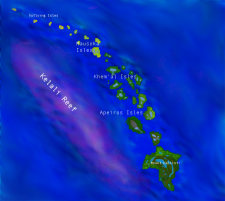
| |||||
| Area | 845,375.52km2 | ||||
| Water (%) | 75% | ||||
| Highest point | Mount Kallisti 3023M | ||||
| Longest river | River Gentu | ||||
| Demographics | |||||
| Population | 102,521,000 | ||||
| • Density | 482 by land (1,206 actual)/km2 | ||||
| • Growth | 0.2%/year | ||||
| Median age | 21.5 years years | ||||
| Demonym | Khem | ||||
| History | |||||
| Founding of Pan-Cefnor Trade Company | 1605 CE
| ||||
| Children of Ta Revolt | 1850 CE | ||||
| Government | |||||
| Capital | Carcossa | ||||
| Official language | Khem | ||||
| Type | Democratic Confederation of City States, Previously Theocratic Principalities | ||||
| Legislature | The Hall of Amenti | ||||
| En'ku | Mk'aelar Bara'war | ||||
| Alkahest | Manas Vol'elen
| ||||
| Islands | 137 | ||||
| Economy | |||||
| Currency | Ta (≗) (T) | ||||
| GDP | ≗ 3.27 trillion | ||||
| • Per capita | ≗ 36,179 | ||||
| • Growth | 9%/year | ||||
| Sectors |
34% Agriculture | ||||
| Unemployment | 2% | ||||
| Gini | .34 | ||||
| Development | |||||
| Life expectancy | 102 years | ||||
| Improved water access | 100% | ||||
| Literacy | 98% | ||||
| Enrollment | 73% | ||||
| • Primary | 73% | ||||
| • Secondary | 65% | ||||
| • Tertiary | 20% | ||||
| Standards | |||||
| Measures | Eluvataran-Myrorian Standard (Metric) | ||||
| Date format | month-day-year | ||||
| Traffic | Right-hand | ||||
| Codes | |||||
| ISO code | AK | ||||
| Internet TLD | .kh | ||||
| Calling code | +42 | ||||
"When I call them Librarians, let me not be understood as meaning no more than the term denotes with you. With us, our Librarians were administrators of all business, art, and science; Directors of trade, commerce, generalship, architecture, engineering, education, statesmanship, legislature, morality, theology; doing nothing themselves, they were the cause of everything worth doing, that was done by others."
-excerpt of a study on Khemish culture by doctoral student Jain Wei while studying at the Imperial College at Fellowmoor-
Khem, sometimes known as The Khem or Al'Khem, is an archipelago nation home to one of Taijitu's oldest civilizations. The Khemish civilization dates back 19,000 BCE as the first evidence of Khemish agrarian villages show themselves emerging from the nomadic al'Ta, there was also a division of burial practices in this time with the al'Khem beginning to use mounds as opposed to the al'Ta tree burial. These agrarian villages eventually became the principalities of Khem, whose caste systems defined the Khemish people for thousands of years. The cities of the al'Khem eventually became engineering marvels of the ancient world, perfectly blending land and water through canals, chinampas, hugelkultur and dams. The wealthy Librarians, the caste at the top of Khem society, controlled nearly everything and lived extravagantly, though eventually losing their grip on reality and soon after ruler-ship. Da'Kavo, a slave soldier caste, patrolled the streets acting as violent enforcers of Library edict in addition to their position in fighting foreign enemies. The builder caste, designed and lived comfortable, simple lives for themselves. While the "Servile" caste ostensibly had it the worst and were the forefront of historic revolutions, riots and civil rights movements. Lastly are the al'Ta who are a scattered tribal people still dwelling in the Hyades rain-forest and along various waterways in al'Khem, they practice an ancient animistic version of the Libraries Path of Truth. It is a multicultural nation, consisting mainly of ethnic Khems, Ozians, Moacians, Jutensans, Iadakans, Fre'zhi, Kar'zhi, Bustians, Lycanthropes, Dunedain, Edain, Minosian, Benn, Finn, Belaedinosi, and Funkadelians. Despite widespread poverty among the working class, an abundance of food ensures no Khem goes hungry.
Government
| Country Name: |
Conventional Long Form: Peoples Confederation of al'Khem |
|---|---|
| National Holidays: |
Freedom Day: February 14 |
Languages:
Official Languages: Khem, Eruvite, Ozian
Recognized Languages: Cefish, Jutensan, (other languages of the Cefnor Basin)
The Most commonly spoken secondary language is Ozian.
Followed closely by Eruvite. Many fisherman and gardeners know Jutensan.
Cefish is known in the service industries such as hotels and bars.
History
- ~100KA BCE: Habitation of the islands of Khem by the Al’Ta people after the [great disaster].
- ~19KA BCE: Evidence of the first Al’Khem agrarian villages, a noted difference with Al’Ta fishing villages.
- ~8000 BCE: First evidence of Chinampas and Hugelkultur Cultivation in the villages of Al’Khem. Al’Ta food forests adopted by Al’Khem.
- ~8000 BCE: Dakhma first used in disposal of corpses by Al’Khem. Later versions of this structure are much larger due to a growing population.
- ~6000 BCE: Al’Ta food forests adopted by Al’Khem.
- ~6000 BCE: Cannabis seeds and oil used for food by Al’Khem.
- ~5000 BCE: Sericulture, the kiln and lacquer developed by Al’Khem.
- ~3900 BCE: Beginnings of the Path of Truth, the Ankesh Tablets erected.
- ~3500 BCE: Gahk'ell first domesticated in Khem.
- ~3100 BCE: The Sindar capture villages of Khem and force them into slavery for seventy generations later these people would be known as the Da’Kavo.
- ~3000 BCE: Sultanates of Khem unite. Begining of Ta Cycle calender
- ~2500 BCE: Fall of Sindar Empire due to slave revolt, the Da’Kavo lead this revolt with their Fre’zhi brethren. Though when they returned to their native lands they weren’t the same, a people hardened by Sindarian cruelty. The Sindarian caste system falls in all but the isles of Khem and the proto-Dunedain.
- ~2500 BCE: Bhaang first found in use among the lower castes of Khem, soon brought into use by the Library of Truth.
- ~2500 BCE: Hanging Gardens first created in Kannabarus, a living love poem to a Praemian princess by the sultan Kl’war’nghe.
- ~2400 BCE: The triplets known as the Hermetica are simultaneously crucified on three islands of Khem, they were considered one person and deified afterward.
- ~2000 BCE: Construction of the first Great Library and its tradition of architectural wonder on Lake Haali. Curiously also the first evidence of coca use.
- ~1985 BCE: Heliocentric model of the solar system first proposed by Hk’laesh of the Great Library of Haali, he was torn apart by hungry otters for his heresy.
- ~1600 -1250 BCE: Da'Kavo (slave soldier) rule founding the Shining Empire, characterised by great prosperity, advances in engineering and well-ordered civic institutions .
- ~1550 BCE: Khems develop mirrors and begin piping sunlight into their subterranean structures.
- ~1400 BCE: Khemish Settler Junks full of livestock and supplies arrive on Jutensan shores.
- ~960 BCE: Porcelain popularizes in Al’Khem.
- ~897 BCE: Schism in Khem as many fight for the body to be sovereign, the Self Heresy eventually becomes the standard teachings of the Library of truth. This was extremely popular among women who previously had no choice in sexual partners.
- ~850 BCE: Rape becomes illegal in Khem. As does beeding outside of caste.
- ~450 BCE: Khem establishes a heliocentric model of the solar system.
- 100-234 CE: Pelagian invasion of Al’Khem, punctuated by short lived victories and territory constantly shifting between factions.
- 250 CE: Eruvist cults discovered by the Great Library of Carcossa, the Akasa’Datu Da’Kavo are formed to root them out.
- 600 CE: The first attempt of Akasa'Datu Da'Kavo to steal the Whispers, the Akasa’Datu are hunted down by Videnti after barely escaping the tower. Beginning of strained relations.
- 600 CE: Ozians blockade Khem in revenge for the Whispers incident.
- 610 CE: Khems make amends for the incident with offers of gold and spices.
- 810 CE: Khemish shipyards boom with activity as The Library invests heavily in the Apa’Datu Da’Kavo and their shipping schemes.
- 1232 CE: First official military use of rockets when Al’Khem used their թռչող հակահրդեհային սուրն (flying fire lances) to repel Ozian invaders from the city Bara’kaal.
- 1345 CE: Khemist Librarians decide to study the bottom of Lake Haali by sectional dredging, biological interest soars as Library Naturalists come to observe the wonders of the world below.
- 1432 CE: The Great Library codifies “Servile Rights” for the first time. This puts an end to Khemish involvement in the slave trade as a supplier and instead the nation focuses on importation of slaves and transition into the servile caste.
- 1610 CE: Pelargir Company chartered.
- 1747 CE: Khemish Whaling peaks.
- 1840 CE: Al’Khem adopts the Gaeanist alphabet, this cuts down significantly on Library paperwork and simplifies the Great Record. The beginning of rewriting the Great Record.
- 1850 CE: Children of Ta Revolution begins.
- 1914 CE: Librarian Nek'ko Tes'h'la develops alternating current bringing also the electrification of Khemish cities with the Gentu River Project. Hydroelectric power becomes a reality.
- 1926 CE: Ozian Communists spread propaganda in Khem, civil unrest rises.
Geography
Al'Khem is an archipelago nation with a tropical rain-forest climate on the central islands and a wet mediterranean climate on the outlying islands. It lies in the south-eastern region of the Cefnor Sea and is considered part of the Pelagean sub-continent within the greater Cefnor super-continent. Roughly 75% of this nations territory is maritime, claiming a large swath of ocean and the Kelali Reefs.
| Climate | Mediterranean Wet(Mausoka Isles, Outlying Isles) | Tropical Rainforest (Mount Kallisti, Khem'al Isles, Apeiros Isles) | |
|---|---|---|---|
| Elevation Extremes | Lowest Point: Lake Haali -.005 m |
Highest Point: Mount Kallisti 3023 m | |
| Seasons | Fog Time Boisaire - Tonneral |
Wet Season Tonneral - Cielidor |
Dry Season Lumidor - Aquiare |
Demographics
Lorem ipsum dolor sit amet, consectetur adipisicing elit, sed do eiusmod tempor incididunt ut labore et dolore magna aliqua. Ut enim ad minim veniam, quis nostrud exercitation ullamco laboris nisi ut aliquip ex ea commodo consequat. Duis aute irure dolor in reprehenderit in voluptate velit esse cillum dolore eu fugiat nulla pariatur. Excepteur sint occaecat cupidatat non proident, sunt in culpa qui officia deserunt mollit anim id est laborum. Lorem ipsum dolor sit amet, consectetur adipisicing elit, sed do eiusmod tempor incididunt ut labore et dolore magna aliqua. Ut enim ad minim veniam, quis nostrud exercitation ullamco laboris nisi ut aliquip ex ea commodo consequat. Duis aute irure dolor in reprehenderit in voluptate velit esse cillum dolore eu fugiat nulla pariatur. Excepteur sint occaecat cupidatat non proident, sunt in culpa qui officia deserunt mollit anim id est laborum. Lorem ipsum dolor sit amet, consectetur adipisicing elit, sed do eiusmod tempor incididunt ut labore et dolore magna aliqua. Ut enim ad minim veniam, quis nostrud exercitation ullamco laboris nisi ut aliquip ex ea commodo consequat. Duis aute irure dolor in reprehenderit in voluptate velit esse cillum dolore eu fugiat nulla pariatur. Excepteur sint occaecat cupidatat non proident, sunt in culpa qui officia deserunt mollit anim id est laborum. Lorem ipsum dolor sit amet, consectetur adipisicing elit, sed do eiusmod tempor incididunt ut labore et dolore magna aliqua. Ut enim ad minim veniam, quis nostrud exercitation ullamco laboris nisi ut aliquip ex ea commodo consequat. Duis aute irure dolor in reprehenderit in voluptate velit esse cillum dolore eu fugiat nulla pariatur. Excepteur sint occaecat cupidatat non proident, sunt in culpa qui officia deserunt mollit anim id est laborum. Lorem ipsum dolor sit amet, consectetur adipisicing elit, sed do eiusmod tempor incididunt ut labore et dolore magna aliqua. Ut enim ad minim veniam, quis nostrud exercitation ullamco laboris nisi ut aliquip ex ea commodo consequat. Duis aute irure dolor in reprehenderit in voluptate velit esse cillum dolore eu fugiat nulla pariatur. Excepteur sint occaecat cupidatat non proident, sunt in culpa qui officia deserunt mollit anim id est laborum.
Population
| Largest metropolitan areas | ||||||
|---|---|---|---|---|---|---|
| # | City | Population | ||||
| 1 | Carcossa | 20,007,000 | ||||
| 2 | Apeiros | 16,703,500 | ||||
| 3 | Azuth | 12,450,900 | ||||
| 4 | Platholenes | 7,197,350 | ||||
| 5 | l'Karevo | 6,129,708 | ||||
| 6 | Kl'war | 6,101,967 | ||||
| 7 | Azu'kaal | 6,095,367 | ||||
| 9 | Mhe'n'war | 5,069,108 | ||||
| 10 | Ta'kaal | 4,069,000 | ||||
| 11 | Apenuur | 4,037,803 | ||||
| 12 | Mk'war | 3,069,605 | ||||
| 13 | Mk'agl | 3,065,192 | ||||
| 14 | Mk'kaal | 3,059,753 | ||||
| 15 | Nak'kaal | 3,048,420 | ||||
| 16 | Rl'yeh | 3,037,858 | ||||
| 17 | Hyaden | 3,025,120 | ||||
| 18 | Barakan | 3,017,148 | ||||
| 19 | Horun | 3,012,593 | ||||
| 20 | Bara'kaal | 2,869,969 | ||||
Culture
This ancient culture is often known as one of the birthplaces of civilization. Khemish influence can be seen in from Ozia to Jutensa. At the heart of this influence is the belief in the commons as a place for their people to live and not merely marketplaces. In the isles of the Khem we see not only a unique architectural style (as well known I expect as the Delfian Nara) but also styles of dress uncommon outside lands they did not help shape. Many visitors to al'Khem remark about how free and candid the Khemish people are when it comes to drug use. Addiction is rare and treated as a mental health issue, the Khems regard addicts as those who feel powerless. Traditional alcoholic beverages and herbal tinctures are served right alongside Letonnese lagers, Ozian zuavka and Eruvite wine (especially enjoyed by the Gardeners for the songs which grace the vineyards). Foreign hairstyles have become increasingly popular since the 1950's, the most popular among young women being the "Fre'dee". Movies are incredibly popular as a group activity with Delfian films often rating top at the box office. Television is largely news, documentaries, morality tales, dramas, comedies, animation and tourist commercials. A do it yourself mentality pervades with many Khems homebrewing, gardening, blacksmithing, leatherworking, etc. A Khem without a craft to their name is an anomaly with basic instruction in art being mandatory in the Khemish education system. There is a disdain for automobiles is unmatched by any but the Ozians (and look at the travesty when they DO make a car!). Many still cling to using Gahk'ell labor and boats when not taking advantage of the immense network of public transportation infrastructure.
Cinema
Literature
Music
Art
Philosophy
Gardening
Science
Engineering
Architecture
Festivals and Holy Days
Natural Features
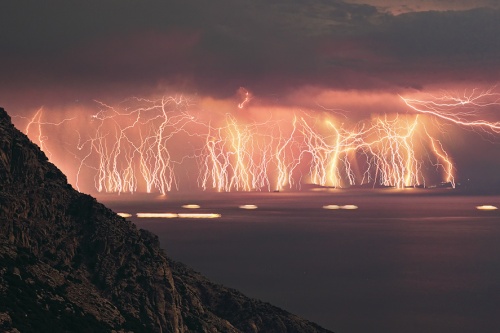
Gentu Lightning
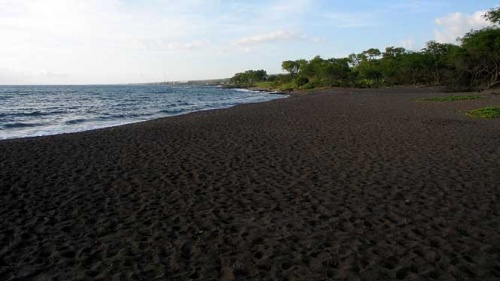
Beaches of Lake Haali
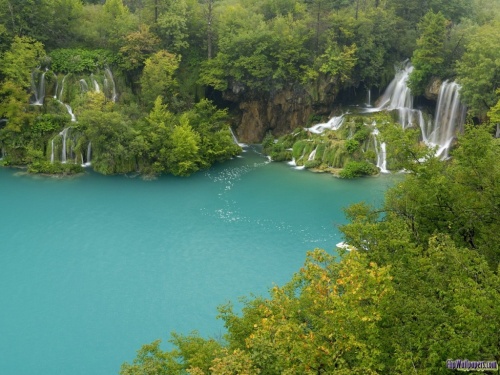
Headwaters of lake Ti'kili
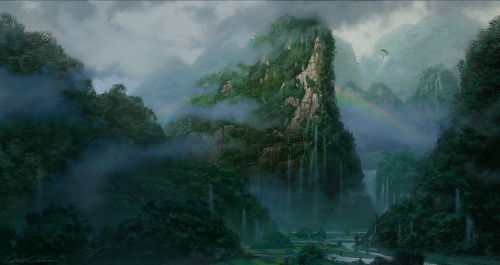
An artistic rendering of the mist bedecked Mount Kallisti
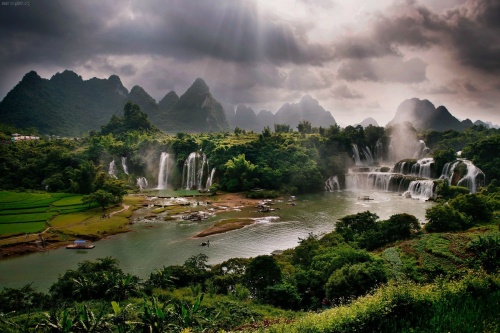
Coy farmers on the River Gentu
| Peoples Confederation of Holy Isles of al'Khem Քհէմ Դափգէֆ Ոփկաէա | |||
|---|---|---|---|
| Cities: | Apeiros, Carcossa, Azuth, Platholenes, l'Karevo, Kl'war, Azu'kaal, Mhe'n'war, Ta'kaal, Apenuur, Mk'war, Mk'agl, Mk'kaal, Nak'kaal, Rl'yeh, Hyaden, Barakan, Horun, Bara'kaal | Islands and Island Groups: | Apeiros, Mount Kallisti, Khem'al, Mausoka, Outlying Islands |
| People: | En'ku, Alkahest, Library Councilmen, Da'Kavo, Craftsmen, Revolutionary Figures | Hierarchy: | Peoples Glorious Libraries of Truth, Peoples Shining Army, Guilds, Slums, INFORMATION RESTRICTED CITIZEN |
| Society: | Religion, People, Standard of living, Khemish Language, Economy, Drug policy | Miscellaneous: | Scientific Achievements, Agriculture Philosophical Contributions, Art, Music, Architecture, Technology, Ecology |


